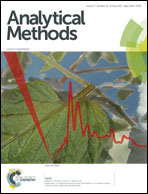Comparison of antioxidant capacity assays with chemometric methods
Abstract
Seven antioxidant capacity assays were compared and evaluated (ranked and grouped) using several statistical methods. The aim of the research was to compare the results of different antioxidant capacity assays and choose preferably one (or two) method(s), which could reproduce on its own the consensus results of all of the others. The two datasets (berries and sour cherries) gave quite similar results. Cluster analysis and principal component analysis could point out the methods that are most similar and best connected to each other. Not only are the groupings of the methods novel in this study but also the application of sum of ranking differences (SRD) and the generalized pair correlation method (GPCM) to compare and rank the various antioxidant capacity assays independently. In the case of berry samples, ferric ion reducing antioxidant power assay (FRAP) was the most successful as demonstrated by the results of SRD and GPCM. Moreover, GPCM (with conditional exact Fisher's test and probability weighted ordering) could distinguish between 2,2-diphenyl-1-picrylhydrazyl free radical scavenging (DPPH) and lipid soluble antioxidant capacity (ACL) methods, which was not revealed by the SRD procedure. In the case of sour cherry samples the total polyphenolic content (TPC) was the most appropriate method and FRAP was the second to replace all the other assays. GPCM could differentiate between FRAP and trolox equivalent antioxidant capacity (TEAC) methods. The suggested techniques were FRAP and TPC for both datasets to replace all the others, whereas the ACL and water soluble antioxidant capacity (ACW) techniques give extremely distant results.


 Please wait while we load your content...
Please wait while we load your content...